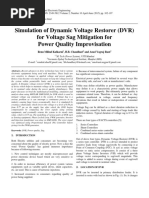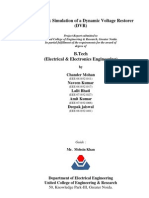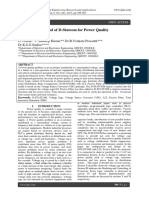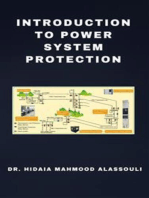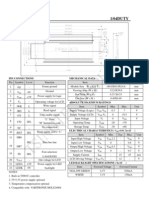Modeling and Performance Analysis of A DVR For Non-Linear Load
Uploaded by
alModeling and Performance Analysis of A DVR For Non-Linear Load
Uploaded by
alIAETSD JOURNAL FOR ADVANCED RESEARCH IN APPLIED SCIENCES ISSN NO: 2394-8442
Modeling and Performance Analysis of a DVR for Non-Linear Load
Amit Barure1, K Chandra Obula Reddy2 ,Pankaj Bhakre3
1
PG Student M.S.S CET, Jalna
amitbarure@gmail.com
2
H.O.D EPS, M.S.S CET, Jalna
Chandra6279@gmail.com
3
Asst. Professor,M.S.S.CET,Jalna
Pankajbhakre11@gmail.com
ABSTRACT: Dynamic voltage restorer (DVR) can provide the most commercial solution to mitigate voltage
sag by injecting voltage as well as power into the system. This paper describes the effectiveness of using dynamic
voltage restorers (DVRs) in order to mitigate voltage sags in power distribution systems at critical loads. The
DVR is a power electronic based device that provides three-phase controllable voltage source, whose voltage
vector (magnitude and angle) adds to the source voltage during sag event, to restore the load voltage to pre-sag
conditions. The DVR can restore the load voltage within few milliseconds. A control technique based on a
proportional–integral (PI) controller and a selective controller is used. The controller is designed in
asynchronously-rotating reference frame. In fact, three independent controllers (homo polar component, d-axis
component and q-axis component) have been used to tackle balanced and unbalanced voltage supplies.
Simulation results using Simulink’ Sim Power System Toolbox is presented to illustrate the principle and
performance of a DVR operation in load voltage compensation.
Keyword : - FACTS, DVR, DQ transformation, power quality, voltage sags
1. INTRODUCTION
At the present, with the increasing demand for electrical energy and rapidly growing number of new
production technologies, the voltage quality requirements are becoming stricter. In order to evaluate the level of
power quality, STN EN 50160 standard was introduced, which stipulates the limits for voltage quality [1].
1.1. Voltage quality in electrical power system
The most severe power quality problems are voltage sags, swells, interruption, harmonics and flickers [2].
Failures due to such disturbances cause a huge impact on production cost. Especially, modern industrial
equipment is more susceptible to power quality problems. STNEN 50160 defines a voltage sag as a short term
reduction in voltage magnitude to a value in the range 5 to 90% of the supply voltage. A voltage sag means that
the required energy is not being delivered to the load and this can have serious consequences depending on the
type of load involved. Reference [2] defines power quality problems as follows: computers or other electronics
damage, lights dim and flickers, loss of synchronization of processing equipment, motors or other process
equipment malfunctions, transformers and cables overheating, problems with power factor correction
equipment, noise interference to telecommunication lines and many more.
VOLUME 5, ISSUE 8, AUGUST/2018 PAGE NO:193
IAETSD JOURNAL FOR ADVANCED RESEARCH IN APPLIED SCIENCES ISSN NO: 2394-8442
Since the whole electrical power network represents a very complex structure, there is no way to control it
without any faults and disturbances. Thus, companies are often forced to save its facilities on their own. One of
the options for power quality and system stability improvement is to introduce FACTS devices [3].
1.2. FACTS controllers
FACTS ( Flexible Alternating Current Transmission systems) are alternating current transmission systems
incorporating power electronic-based and other static controllers to enhance controllability and increase power
transfer capability [4].
The major advantages of FACTS are [5]:
power lines transmission capabilities improvement,
power flow control,
static and dynamic stability enhancement,
secure interconnections between neighboring utilities.
FACTS controllers are able to control and regulate one or several key parameters in power transmission, such
as current, voltage, active, reactive power, frequency or phase angle. Reference [5] divides FACTS into four
basic types – series connected, shunt connected, combined series-series and combined series-shunt controllers.
The main disadvantage of implementing FACTS is very a high price of these devices and economic
requirements. The series controller can be a variable impedance, such as capacitor and reactor, or a power
electronics based variable voltage source. In general, all series controllers inject voltage in series with the line.
They are able to compensate voltage sags or swells and eliminate harmonic distortion as well. These are static
synchronous series controller (SSSC), thyristor-controlled series capacitor (TCSC) or dynamic voltage restorer
(DVR). As in the case of series controllers, the shunt controllers may be variable impedance, variable source, or
a combination of these. In basic principle, all shunt controllers inject current into the system at the point of
connection. These are static thyristor controlled reactor (TCR), synchronous controller (STATCOM) or static
var compensator (SVC). Combined series-shunt controllers are the most flexible and sophisticated FACTS
devices. They are able to regulate and affect many different parameters at the same time. One of these devices is
unified power flow controller (UPFC).
2. DYNAMIC VOLTAGE RESTORER
Dynamic Voltage Restorer (DVR) belongs to series connected FACTS controllers. The primary function of a
DVR is to compensate voltage sags and swells but it can also perform tasks such as harmonics elimination,
reduction of voltage transients and fault current limitation [6]. DVR is usually installed between a source and a
critical load that should be protected. Even the shortest voltage sag can cause serious equipment damage,
interruption of production cycles and thus financial losses as well.
In general a DVR consists of three parts (Fig. 1.):
measuring unit
control
power circuit
VOLUME 5, ISSUE 8, AUGUST/2018 PAGE NO:194
IAETSD JOURNAL FOR ADVANCED RESEARCH IN APPLIED SCIENCES ISSN NO: 2394-8442
The measuring unit provides voltage and current measurements. The outputs are voltage and current analog
signals ( u, i), which enter the control unit. The control unit converts these signals to their digital representation
using A/D converter so that they can be processed by a microprocessor (DSP – digital signal microprocessor). Next
part is a voltage sags detection algorithm followed by compensating voltage calculation U_com, which is the
voltage needed to be injected into the system in order to remain the load side voltage of purely sinusoidal
waveform. Power section consists of a voltage source converter (VSC) equipped with a LC filter to smooth the
output voltage, a DC energy storage and an injection transformer (TR) – booster.
The basic principle of DVR function is to inject or draw the compensating voltage U_inj to or from the
supply voltage U_s in order to mitigate voltage sags or swells on the load side U_load. At every moment the
control algorithm compares desired voltage and actual measured voltage. The difference between these two
signals is considered as a compensating voltage signal (control signal) U_com, which is directly proportional to
compensating voltage U_inj (power circuit). U_com is a digital input signal for a pulse width modulation (PWM)
to control the voltage source converter. The VSC converts DC energy stored in an energy storage device (such
as batteries or supercapacitors) to injecting AC voltage that is to be superimposed to the source voltage. DVR
power output depends on the amount of energy that can be stored in the energy storage unit.
Fig. 1 Simplified Scheme of DVR
DVRs are normally installed to protect large electrical energy consumers with the sensitive technologies and
devices (2 MVA or more) connected at distribution voltage [9].
3. VOLTAGE SAGS DETECTION METHODS
One of the most important requirements for DVR is that the controller should be able to operate in real-time
manner. It means that the whole compensating process is carried out immediately, after a failure occurs, without
any delay. The very important factor that influences the DVR speed most is the reaction time of the
implemented voltage sag detection algorithm. The best DVR systems are able to react within 1 ms.
There are several voltage sags detection techniques, which can be used in DVRs, such as:
peak value method,
missing voltage method,
RMS method,
VOLUME 5, ISSUE 8, AUGUST/2018 PAGE NO:195
IAETSD JOURNAL FOR ADVANCED RESEARCH IN APPLIED SCIENCES ISSN NO: 2394-8442
discrete Fourier transformation,
DQ transformation,
Hybrid methods.
In this paper the modeling of a DVR is proposed. Its control algorithm is based on DQ transformation. DQ
transformation (dq0 – direct-quadrature -zero) is a mathematical transformation used to simplify the analysis of
three-phase circuits [8]. d and q quantities represent rectangular two axis system, which rotates with angular
frequency ω [7]. In the case of symmetric three-phase system, introducing of the dq0 transformation reduces
three AC quantities (pu) to two DC quantities (d=1, q=0) . Any deviations from the steady state condition in
abc system reflect in changes of dq0 values in real-time. For unbalanced and asymmetric three phase system
applies d≠0, q≠0, 0≠0. According to this presumption it is possible to obtain the difference between desired
and instant values dynamically. Therefore, the output compensating voltage can be controlled by PID regulators
[3]. The resultant signal is converted back to abc values. DQ transformation can be applied in the case of three-
phase system and there is a phase-locked loop (PLL) required to lock the synchronization of the compensating
voltage in phase with the line voltage before the fault.
4. SIMULATION MODEL OF A DVR IN SIMULINK
In order to confirm the correct function of the proposed control algorithm it was necessary to create
simulation model. For this purpose Simulink was used. The model is presented in Fig. 2. It consists of a 0.38 kV
electrical source, which represents a 0.38 kV distribution network, a power line, a distribution transformer ( TR 1)
which feds the sensitive load. There is DVR connected to the line right before the load that is protected. The
different faults are generated by the block “fault”. The variable U_bef is the voltage which is measured before the
point of connection of the DVR and voltage U_load is the load side voltage that is measured at the load
terminals. The lower part of the simulation model is DVR. It consists of measuring unit (U_load), control and
power unit (voltage source converter, LC filter, series transformer and energy storage). When DVR is idle, the
energy storage device is being recharged. The maximum amount of energy stored at the rated voltage 380 V.
Fig.2 Proposed control scheme in Simulink
Fig. 2 shows the proposed control algorithm that is used for DVR automatic regulation of compensating
voltage. It starts with measured three-phase load voltage U_load. These values are transformed to dq0 system
and they are compared with references values. The difference enters PID regulator.
VOLUME 5, ISSUE 8, AUGUST/2018 PAGE NO:196
IAETSD JOURNAL FOR ADVANCED RESEARCH IN APPLIED SCIENCES ISSN NO: 2394-8442
PID controller regulates compensating voltage U_com, which is transformed back to abc system and the
resultant voltage is sent to PWM module. And thus VSC is controlled by means of IGBTs’ switching pulses.
5. SIMULATION RESULTS
The simulation model of DVR is designed to mitigate voltage sags and phase angle changes as well. It
implements compensation method pre-sag which means that DVR is able to correct phase angle changes during a
fault. Phase angle of voltage waveform is kept constant at the value as it was before the sag. Many different
simulations with various types of sags have been tested.
5.1. Three-phase sag
First of all, three-phase sag mitigation is presented. Fig. 4 illustrates three different pictures. First waveform
depicts the voltage before DVR (U_bef), the second one is compensating voltage U_com and the third one shows
load voltage U_load.
Fig.3 DVR output, Load side Wave
Fig. 4 Proposed MATLAB Model of DVR
6. CONCLUSION
To sum up, the presented DVR simulation model is based on a DQ transformation control algorithm. The
main advantages of this control technique are high speed, simplicity and it can be used even during distorted
supply voltage waveform.
VOLUME 5, ISSUE 8, AUGUST/2018 PAGE NO:197
IAETSD JOURNAL FOR ADVANCED RESEARCH IN APPLIED SCIENCES ISSN NO: 2394-8442
On the other hand the disadvantages are that DQ transformation can be only applied on a three phase
system and a reference sinusoidal signal is required (PLL) synchronized with the voltage before the fault. The
entire DVR model was created in Matlab/Simulink and its correct function was verified by several simulation
tests. The obtained results showed that, the proposed DVR mitigates voltage sags and harmonics very fast and
reliably. Many other parameters and conditions influence the DVR operation. They are: sampling frequency,
speed of the regulators, dynamic behavior of energy storage device, converter switching speed and the type of
the disturbance. The right choice of a reliable voltage sag detection method and a proper design of the whole
system is the very first step in the developing of a DVR. Thus, the proposed simulation model can support the
next research in the field.
REFERENCES
[1] STN EN 50160, “Charakteristiky napätia elektrickej energie dodávanej z verejnej distribučnej siete,” Slovak technical
standard, SÚTN, Bratislava, 2010.
[2] D. Chapman, “Introduction to power quality,” European Copper Institute publication, February 2012.
[3] P. Hečko, “Kompenzace krátkodobých poklesů a přerušení napětí v distribuční soustavě,” University of Žilina, faculty of
electrical engineering, 2010. Dissertation thesis.
[4] IEEE, “Proposed terms and definitions for flexible AC transmission system (FACTS),” IEEE Xplore digital library,
October 1997. ISSN0885-8977
[5] G. N. Hingorani, L. Gyugyi, “Understanding FACTS. Concepts and Technology of Flexible AC Transmission Systems,”
New York: IEEE Press, 2000. p. 432. ISBN 0-7803-3455-8
[6] M. N. Tandjaoui, et al., “Sensitive Loads Voltage Improvement Using Dynamic Voltage Restorer,” International Conference
on Electrical Engineering and Informatics, 2011. Conference publication. IEEE Xplore digital library
[7] M. Gonzalez, “DQ transformation development for single-phase systems to compensate harmonic distortion and reactive power,”
Power Electronics Congress, 2004. CIEP 2004. 9th IEEE International. p. 177-182
[8] R. A. Kantaria, “A novel technique for mitigation of voltage sag/swell by Dynamic Voltage Restorer,” Electro/Information
Technology (EIT), 2010 IEEE International Conference. Conference publication. p. 1-4
[9] M. Minarčík and A. Otčenášová, “Practical measurement of power quality and the possibility of its improvement,” 12-th
International Scientific Conference Electric Power Engineering 2011, Kouty nad Desnou, Czech Republic, 2011, p. 478-481,
ISBN 978-80-248-2393
VOLUME 5, ISSUE 8, AUGUST/2018 PAGE NO:198
You might also like
- Application of Dynamic Voltage Restorer in Electrical Distribution System For Voltage Sag CompensationNo ratings yetApplication of Dynamic Voltage Restorer in Electrical Distribution System For Voltage Sag Compensation9 pages
- Understanding of Dynamic Voltage: Restorers Through MATLAB SimulationNo ratings yetUnderstanding of Dynamic Voltage: Restorers Through MATLAB Simulation6 pages
- Using Fast Fourier Extraction Method Power Quality Improvement by DVR For Unbalanced Voltage Sag-Swell ControlNo ratings yetUsing Fast Fourier Extraction Method Power Quality Improvement by DVR For Unbalanced Voltage Sag-Swell Control7 pages
- Modeling and Simulation of A Dynamic Voltage Restorer (DVR)100% (1)Modeling and Simulation of A Dynamic Voltage Restorer (DVR)49 pages
- Dynamic Voltage Restorer For Voltage Sag/Swell MitigationNo ratings yetDynamic Voltage Restorer For Voltage Sag/Swell Mitigation9 pages
- Mitiation of Voltage Sag Using Dynamic Voltage Restorer (DVR)No ratings yetMitiation of Voltage Sag Using Dynamic Voltage Restorer (DVR)5 pages
- By Dynamic Voltage Restorerfor Power Quality ImprovementNo ratings yetBy Dynamic Voltage Restorerfor Power Quality Improvement6 pages
- Power Quality Improvement Using Dynamic Voltage Restorer (DVR)No ratings yetPower Quality Improvement Using Dynamic Voltage Restorer (DVR)7 pages
- Voltage Sag and Mitigation Using Dynamic Voltage Restorer (DVR) SystemNo ratings yetVoltage Sag and Mitigation Using Dynamic Voltage Restorer (DVR) System6 pages
- Simulation and Implementation of DVR For Voltage Sag CompensationNo ratings yetSimulation and Implementation of DVR For Voltage Sag Compensation5 pages
- Voltage Sag and Mitigation Using Dynamic Voltage Restorer (DVR) SystemNo ratings yetVoltage Sag and Mitigation Using Dynamic Voltage Restorer (DVR) System6 pages
- Advanced Control of The Dynamic Voltage Restorer For Mitigating Voltage Sags in Power SystemsNo ratings yetAdvanced Control of The Dynamic Voltage Restorer For Mitigating Voltage Sags in Power Systems10 pages
- Iaetsd-Minimization of Voltage Sags and Swells Using DVRNo ratings yetIaetsd-Minimization of Voltage Sags and Swells Using DVR8 pages
- 20jul201505074843 Renu Milind Kulkarni 102-107No ratings yet20jul201505074843 Renu Milind Kulkarni 102-1076 pages
- Power Quality Improvement Using Dynamic Voltage RestorerNo ratings yetPower Quality Improvement Using Dynamic Voltage Restorer4 pages
- Power Quality Enhancement Using Custom PNo ratings yetPower Quality Enhancement Using Custom P7 pages
- Power Quality Enhancement Using Custom Power DevicesNo ratings yetPower Quality Enhancement Using Custom Power Devices7 pages
- Role of Custom Power Devices in Power Quality Enhancement: A ReviewNo ratings yetRole of Custom Power Devices in Power Quality Enhancement: A Review7 pages
- Power Quality Enhancement Using Dynamic Voltage Restorer (D.V.R)No ratings yetPower Quality Enhancement Using Dynamic Voltage Restorer (D.V.R)41 pages
- Study of Major Issues and Their Impact On DVR System PerformanceNo ratings yetStudy of Major Issues and Their Impact On DVR System Performance6 pages
- Single Phase Dynamic Voltage Restorer For Abnormal ConditionsNo ratings yetSingle Phase Dynamic Voltage Restorer For Abnormal Conditions5 pages
- Power Quality Improvement in Distribution System Using D-Statcom in Transmission LinesNo ratings yetPower Quality Improvement in Distribution System Using D-Statcom in Transmission Lines5 pages
- Modelling Voltage Sag Mitigation Using Dynamic Voltage Restorer and Analyzing Power Quality IssueNo ratings yetModelling Voltage Sag Mitigation Using Dynamic Voltage Restorer and Analyzing Power Quality Issue9 pages
- Study of Different Methods For Enhancing Power Quality P RoblemsNo ratings yetStudy of Different Methods For Enhancing Power Quality P Roblems8 pages
- Operation of D Statcom in Voltage Control Mode IJERTV7IS090086No ratings yetOperation of D Statcom in Voltage Control Mode IJERTV7IS0900868 pages
- Mitigation of voltage sag and voltage swell by using dynamic voltage restorerNo ratings yetMitigation of voltage sag and voltage swell by using dynamic voltage restorer10 pages
- Multifunctional Dynamic Voltage Restorer Implementation For Emergency Control in Distribution SystemsNo ratings yetMultifunctional Dynamic Voltage Restorer Implementation For Emergency Control in Distribution Systems5 pages
- Enhancing Power Quality With Improved Dynamic Voltage RestorerNo ratings yetEnhancing Power Quality With Improved Dynamic Voltage Restorer7 pages
- Voltage Sag Compensation Using Dynamic Voltage Restorer: Mayank Paliwal, Rohit Chandra Verma and Shaurya RastogiNo ratings yetVoltage Sag Compensation Using Dynamic Voltage Restorer: Mayank Paliwal, Rohit Chandra Verma and Shaurya Rastogi10 pages
- A Versatile Control Scheme For A Dynamic Voltage Restorer For Power Quality ImprovementNo ratings yetA Versatile Control Scheme For A Dynamic Voltage Restorer For Power Quality Improvement23 pages
- Power Quality Improvement For Non Linear Ffe96ec1No ratings yetPower Quality Improvement For Non Linear Ffe96ec16 pages
- Power Quality Enhancement Using DVR: Ee Department, SRMGPC, Lucknow 1No ratings yetPower Quality Enhancement Using DVR: Ee Department, SRMGPC, Lucknow 18 pages
- Presented By:: Head of The Department Project GuideNo ratings yetPresented By:: Head of The Department Project Guide14 pages
- BES 516-300-S266-S4 Order Code: BHS0034: Inductive SensorNo ratings yetBES 516-300-S266-S4 Order Code: BHS0034: Inductive Sensor2 pages
- 08 Lab Manual - Program To Find Out Factorial of A NumberNo ratings yet08 Lab Manual - Program To Find Out Factorial of A Number4 pages
- Supplementary Notes For EE-201 (H. Saadat) Power in Single-Phase Ac CircuitsNo ratings yetSupplementary Notes For EE-201 (H. Saadat) Power in Single-Phase Ac Circuits13 pages
- Software Requirements Specification: Exam EarnNo ratings yetSoftware Requirements Specification: Exam Earn22 pages
- Suggested Installation Equipment (Not Supplied With Kit) Safety Instructions DangerNo ratings yetSuggested Installation Equipment (Not Supplied With Kit) Safety Instructions Danger2 pages
- Enhanced Vibration Performance of Ultrasonic Block HornsNo ratings yetEnhanced Vibration Performance of Ultrasonic Block Horns5 pages
- Application of Dynamic Voltage Restorer in Electrical Distribution System For Voltage Sag CompensationApplication of Dynamic Voltage Restorer in Electrical Distribution System For Voltage Sag Compensation
- Understanding of Dynamic Voltage: Restorers Through MATLAB SimulationUnderstanding of Dynamic Voltage: Restorers Through MATLAB Simulation
- Using Fast Fourier Extraction Method Power Quality Improvement by DVR For Unbalanced Voltage Sag-Swell ControlUsing Fast Fourier Extraction Method Power Quality Improvement by DVR For Unbalanced Voltage Sag-Swell Control
- Modeling and Simulation of A Dynamic Voltage Restorer (DVR)Modeling and Simulation of A Dynamic Voltage Restorer (DVR)
- Dynamic Voltage Restorer For Voltage Sag/Swell MitigationDynamic Voltage Restorer For Voltage Sag/Swell Mitigation
- Mitiation of Voltage Sag Using Dynamic Voltage Restorer (DVR)Mitiation of Voltage Sag Using Dynamic Voltage Restorer (DVR)
- By Dynamic Voltage Restorerfor Power Quality ImprovementBy Dynamic Voltage Restorerfor Power Quality Improvement
- Power Quality Improvement Using Dynamic Voltage Restorer (DVR)Power Quality Improvement Using Dynamic Voltage Restorer (DVR)
- Voltage Sag and Mitigation Using Dynamic Voltage Restorer (DVR) SystemVoltage Sag and Mitigation Using Dynamic Voltage Restorer (DVR) System
- Simulation and Implementation of DVR For Voltage Sag CompensationSimulation and Implementation of DVR For Voltage Sag Compensation
- Voltage Sag and Mitigation Using Dynamic Voltage Restorer (DVR) SystemVoltage Sag and Mitigation Using Dynamic Voltage Restorer (DVR) System
- Advanced Control of The Dynamic Voltage Restorer For Mitigating Voltage Sags in Power SystemsAdvanced Control of The Dynamic Voltage Restorer For Mitigating Voltage Sags in Power Systems
- Iaetsd-Minimization of Voltage Sags and Swells Using DVRIaetsd-Minimization of Voltage Sags and Swells Using DVR
- Power Quality Improvement Using Dynamic Voltage RestorerPower Quality Improvement Using Dynamic Voltage Restorer
- Power Quality Enhancement Using Custom Power DevicesPower Quality Enhancement Using Custom Power Devices
- Role of Custom Power Devices in Power Quality Enhancement: A ReviewRole of Custom Power Devices in Power Quality Enhancement: A Review
- Power Quality Enhancement Using Dynamic Voltage Restorer (D.V.R)Power Quality Enhancement Using Dynamic Voltage Restorer (D.V.R)
- Study of Major Issues and Their Impact On DVR System PerformanceStudy of Major Issues and Their Impact On DVR System Performance
- Single Phase Dynamic Voltage Restorer For Abnormal ConditionsSingle Phase Dynamic Voltage Restorer For Abnormal Conditions
- Power Quality Improvement in Distribution System Using D-Statcom in Transmission LinesPower Quality Improvement in Distribution System Using D-Statcom in Transmission Lines
- Modelling Voltage Sag Mitigation Using Dynamic Voltage Restorer and Analyzing Power Quality IssueModelling Voltage Sag Mitigation Using Dynamic Voltage Restorer and Analyzing Power Quality Issue
- Study of Different Methods For Enhancing Power Quality P RoblemsStudy of Different Methods For Enhancing Power Quality P Roblems
- Operation of D Statcom in Voltage Control Mode IJERTV7IS090086Operation of D Statcom in Voltage Control Mode IJERTV7IS090086
- Mitigation of voltage sag and voltage swell by using dynamic voltage restorerMitigation of voltage sag and voltage swell by using dynamic voltage restorer
- Multifunctional Dynamic Voltage Restorer Implementation For Emergency Control in Distribution SystemsMultifunctional Dynamic Voltage Restorer Implementation For Emergency Control in Distribution Systems
- Enhancing Power Quality With Improved Dynamic Voltage RestorerEnhancing Power Quality With Improved Dynamic Voltage Restorer
- Voltage Sag Compensation Using Dynamic Voltage Restorer: Mayank Paliwal, Rohit Chandra Verma and Shaurya RastogiVoltage Sag Compensation Using Dynamic Voltage Restorer: Mayank Paliwal, Rohit Chandra Verma and Shaurya Rastogi
- A Versatile Control Scheme For A Dynamic Voltage Restorer For Power Quality ImprovementA Versatile Control Scheme For A Dynamic Voltage Restorer For Power Quality Improvement
- Power Quality Enhancement Using DVR: Ee Department, SRMGPC, Lucknow 1Power Quality Enhancement Using DVR: Ee Department, SRMGPC, Lucknow 1
- Presented By:: Head of The Department Project GuidePresented By:: Head of The Department Project Guide
- Analog Dialogue, Volume 46, Number 3: Analog Dialogue, #7From EverandAnalog Dialogue, Volume 46, Number 3: Analog Dialogue, #7
- BES 516-300-S266-S4 Order Code: BHS0034: Inductive SensorBES 516-300-S266-S4 Order Code: BHS0034: Inductive Sensor
- 08 Lab Manual - Program To Find Out Factorial of A Number08 Lab Manual - Program To Find Out Factorial of A Number
- Supplementary Notes For EE-201 (H. Saadat) Power in Single-Phase Ac CircuitsSupplementary Notes For EE-201 (H. Saadat) Power in Single-Phase Ac Circuits
- Suggested Installation Equipment (Not Supplied With Kit) Safety Instructions DangerSuggested Installation Equipment (Not Supplied With Kit) Safety Instructions Danger
- Enhanced Vibration Performance of Ultrasonic Block HornsEnhanced Vibration Performance of Ultrasonic Block Horns




















